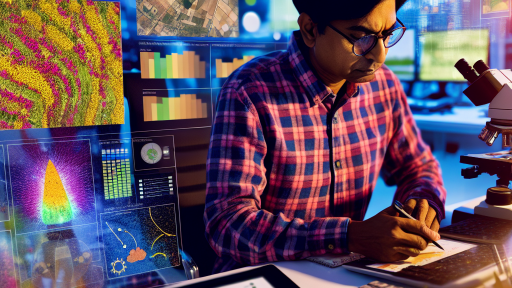Introduction to Soil Health
Importance of Soil Health
Soyl health is vital for sustainable agriculture.
Healthy soil supports crop growth and productivity.
It also facilitates the efficient use of nutrients.
Moreover, healthy soil helps retain water.
This retention reduces the need for irrigation.
Additionally, soil health contributes to biodiversity.
It nurtures various organisms that benefit ecosystem stability.
Current Challenges in Soil Management
Today, soil faces numerous challenges that require attention.
One major issue is soil degradation caused by intensive agriculture.
These practices deplete nutrients and disrupt soil structure.
Furthermore, erosion poses a significant threat to soil health.
It leads to loss of topsoil rich in organic matter.
Contamination from pesticides and heavy metals also affects soils.
This contamination jeopardizes crop safety and human health.
Necessity for Innovative Solutions
Innovative solutions are crucial for improving soil health.
Transform Your Agribusiness
Unlock your farm's potential with expert advice tailored to your needs. Get actionable steps that drive real results.
Get StartedRobotics and technology can play a transformative role.
These advancements can address management challenges effectively.
Automation can enhance efficiency in soil monitoring.
It allows for precision applications of fertilizers and amendments.
Moreover, data-driven solutions can improve decision-making processes.
Overview of Robotics in Agriculture
Definition and Types of Robots
Robotics in agriculture refers to the use of machines in farming activities.
These machines can automate tasks, enhance productivity, and reduce labor costs.
There are several types of robots utilized in agricultural practices.
Autonomous Tractors
Autonomous tractors operate without human intervention.
They can perform tasks such as plowing, planting, and harvesting efficiently.
Farmers can schedule operations to optimize fieldwork.
Drones
Drones play a crucial role in modern agriculture by providing aerial imagery.
They monitor crop health and assess field conditions.
Farmers use drones for precise mapping and resource application.
Robotic Harvesters
Robotic harvesters are designed to pick fruits and vegetables.
They enable faster harvesting and can reduce damages to crops.
These machines work tirelessly day and night, increasing efficiency.
Soil Analysis Robots
Soil analysis robots gather data on soil health and conditions.
They regularly sample soil to assess nutrient levels and pH balance.
Farmers utilize this data to make informed decisions regarding fertilization.
Weeding Robots
Weeding robots identify and remove unwanted plants efficiently.
They minimize the need for herbicides, promoting environmentally friendly practices.
These robots work autonomously throughout the growing season.
By automating tasks, farmers can focus on strategic planning and management.
Showcase Your Farming Business
Publish your professional farming services profile on our blog for a one-time fee of $200 and reach a dedicated audience of farmers and agribusiness owners.
Publish Your ProfileRobotic Technology Applications for Soil Monitoring and Assessment
Introduction to Soil Monitoring Technologies
Robots play a crucial role in monitoring soil health.
They help farmers gather detailed soil data efficiently.
This data enables informed decision-making for crop management.
Types of Robotic Systems for Soil Assessment
Different robotic systems are designed for various soil assessments.
Autonomous drones offer aerial views of farming areas.
They assess soil moisture and nutrient levels effectively.
Ground robots can navigate fields and collect soil samples.
These robots analyze soil composition and structure on-site.
Benefits of Using Robots in Soil Management
Utilizing robots improves precision in agricultural practices.
They enhance efficiency by reducing human errors.
Additionally, robots can operate continuously without fatigue.
This leads to more accurate and timely data collection.
Examples of Current Innovations in Robotic Soil Assessment
Several companies are leading in robotic soil assessment technologies.
AgRobot Inc. focuses on precision agriculture solutions.
Their autonomous vehicles analyze soil health quickly.
SoilSense Technologies employs advanced sensors in drones.
These sensors provide real-time data on soil conditions.
Future Trends in Robotic Soil Monitoring
The future of robotic soil management looks promising.
Advancements in artificial intelligence will enhance analysis capabilities.
Integration with IoT will allow for smarter farming solutions.
Furthermore, collaboration between tech companies and farmers is crucial.
This partnership will drive innovation and improve sustainability.
Delve into the Subject: The Future of Farming with Smart Irrigation
Soil Health Improvement Techniques: Traditional vs. Robotic Methods
Traditional Soil Health Improvement Techniques
Farmers have relied on traditional techniques for generations.
These methods often include crop rotation and cover cropping.
Additionally, incorporating organic matter enhances soil structure.
Moreover, farmers use tillage to manage weeds and aerate the soil.
However, these practices can disrupt soil ecosystems.
Limitations of Traditional Methods
Traditional methods can be labor-intensive and time-consuming.
They also require significant knowledge of soil management.
Consequently, not all farmers can implement effective techniques.
Furthermore, some methods can lead to soil erosion over time.
Robotic Methods for Soil Health Improvement
Robotic technology offers innovative solutions for soil health.
These robots can efficiently perform tasks such as soil sampling.
They analyze soil conditions with high precision and speed.
This data empowers farmers to make informed decisions.
Furthermore, robotics minimize soil disturbance during farming operations.
Advantages of Robotic Techniques
- Robots can monitor soil health continuously.
- They reduce labor costs and increase efficiency.
- Robotic systems can apply precise amounts of nutrients.
- This reduces waste and environmental impact.
Integrating Both Approaches
Many experts believe in a combined approach to soil health.
Integrating robotics with traditional techniques may yield optimal results.
Farmers can leverage the strengths of both methods effectively.
Showcase Your Farming Business
Publish your professional farming services profile on our blog for a one-time fee of $200 and reach a dedicated audience of farmers and agribusiness owners.
Publish Your ProfileSubsequently, this may enhance crop yields and soil vitality.
Explore Further: Data-Driven Irrigation Strategies for Farmers
Case Studies: Successful Implementation of Robots for Soil Management
Innovative Use of Drones in Precision Agriculture
Farmers across the Midwest are using drones for soil analysis.
These drones gather data on soil moisture and nutrient levels.
Consequently, farmers can make informed decisions quickly.
One notable case is Lucas Farms in Iowa.
This farm increased its yield by 15% using drone technology.
Moreover, the farm reduced resource waste significantly.
Autonomous Tractors Enhancing Soil Tillage
In California, autonomous tractors are transforming tillage practices.
These robots operate efficiently without human intervention.
They minimize soil compaction and improve soil health.
For instance, Green Acres Farm reported better soil structure.
As a result, crop yields increased by 20% season-over-season.
The precision of these machines allows for optimized planting strategies.
Soi Sensors for Real-Time Monitoring
Robotic sensors are becoming common in crowded agricultural fields.
These sensors monitor soil conditions in real-time.
Through continuous data collection, farmers can adjust practices promptly.
Agritech Innovations implemented sensors at Sunnyvale Orchards.
They observed significant improvements in water retention rates.
This led to decreased irrigation costs for the orchard.
Integrating Robots with Traditional Farming Techniques
Some farms are successfully combining robots with traditional methods.
A partnership between Farm Tech Solutions and Hilltop Farms exemplifies this.
They utilize robots for soil testing while maintaining manual planting.
This hybrid approach maximizes efficiency and soil management.
As a result, Hilltop Farms has reported enhanced crop health.
Farmers now have the best of both worlds with technology and tradition.
See Related Content: Smart Irrigation Systems in Precision Agriculture

Impact of Robots on Soil Fertility
Benefits of Robotic Technology
Robots enhance soil health by providing precise data analysis.
This analysis allows farmers to apply nutrients effectively.
Consequently, crops receive the right amount of fertilizer.
Additionally, robots can automate soil sampling processes.
This automation reduces labor costs significantly.
Furthermore, robots can monitor soil moisture continuously.
This helps ensure optimal irrigation practices are maintained.
As a result, water usage becomes more efficient.
Enhancing Nutrient Management
Robots facilitate better nutrient management through real-time data.
They identify deficiencies that can impact crop yields.
Moreover, autonomous systems can deliver targeted applications.
This targeted approach minimizes waste and runoff.
Consequently, environmental impacts are reduced.
Showcase Your Farming Business
Publish your professional farming services profile on our blog for a one-time fee of $200 and reach a dedicated audience of farmers and agribusiness owners.
Publish Your ProfileRobotics also allows for fast adjustments to changing conditions.
Limitations of Robotic Implementation
Despite the benefits, adopting robots in agriculture presents challenges.
Initial investment costs for robotic systems can be high.
Moreover, farmers may require training for effective operation.
Additionally, technical failures can disrupt field operations.
Regular maintenance is crucial to prevent downtime.
Technological Dependencies
Reliance on technology can expose farms to cyber threats.
Farmers must implement robust cybersecurity measures.
Loss of traditional farming skills may also occur.
Therefore, maintaining a balance between tech and tradition is vital.
Future Prospects
Robots have the potential to revolutionize soil management.
As technology advances, costs are likely to decrease.
This could make robotic solutions accessible to more farmers.
Ultimately, improved soil health will enhance food security worldwide.
Explore Further: Real-Time Crop Monitoring with Advanced Sensors
Future Trends in Robotic Technology for Sustainable Soil Practices
Advancements in Soil Monitoring
Robotic technology enhances soil monitoring capabilities significantly.
Farmers can now access real-time data on soil conditions.
This includes moisture levels, nutrient composition, and pH balance.
Such precision helps in making informed decisions for crop management.
Integration of AI in Robotics
Artificial intelligence plays a crucial role in soil health management.
AI algorithms analyze complex soil data quickly and accurately.
These insights enable farmers to optimize their fertilization strategies.
Additionally, they can predict potential soil issues before they arise.
Autonomous Soil Restoration
Robots are leading the way in autonomous soil restoration practices.
They can efficiently distribute organic amendments, like compost.
Furthermore, these machines assist in cover crop planting.
Ultimately, this reduces soil erosion and enhances fertility.
Collaboration with Precision Agriculture
Robotics and precision agriculture work hand in hand.
This collaboration ensures efficient resource utilization on farms.
For instance, drones assess field variability and direct robots accordingly.
These technologies together optimize yield while minimizing waste.
Reducing Labor Costs
The introduction of robots significantly reduces labor costs.
Farmers can allocate their workforce to more strategic tasks.
As a result, they increase overall productivity on their farms.
Moreover, robots operate efficiently around the clock, enhancing outputs.
Future Innovations on the Horizon
Emerging technologies promise even greater advancements in soil management.
For example, biotechnology may enhance robot capabilities considerably.
These innovations will likely promote sustainable farming practices.
Farmers will be better equipped to respond to environmental challenges.
The Role of Robotics in the Future of Agriculture and Soil Health
Enhancing Soil Monitoring
Robots significantly enhance soil monitoring techniques.
Showcase Your Farming Business
Publish your professional farming services profile on our blog for a one-time fee of $200 and reach a dedicated audience of farmers and agribusiness owners.
Publish Your ProfileThey collect data on soil conditions in real-time.
This data helps farmers make informed decisions.
Additionally, robots can identify, analyze, and manage soil health issues.
Optimizing Resource Use
Robotics optimizes the use of water and fertilizers.
They deliver precise amounts based on soil requirements.
Consequently, this minimizes waste and environmental impact.
Farmers can increase efficiency and crop yields through this technology.
Supporting Sustainable Practices
Robots play a vital role in sustainable farming practices.
They assist in soil aeration and minimizing soil compaction.
This promotes healthier root systems and better crop growth.
Moreover, robots can help implement cover cropping strategies.
Future Innovations and Developments
The future of robotics in agriculture looks promising.
Innovations in AI and machine learning will enhance their capabilities.
Future robots might include multi-functional systems for various tasks.
These developments will make sustainable farming even more efficient.
Collaboration with Farmers
Robots improve collaboration between technology and traditional farming methods.
Farmers gain access to advanced tools for improved productivity.
This partnership drives the agriculture sector towards modernization.
As such, farmers can optimize yields while preserving soil health.
Additional Resources
Agriculture Innovation: 10 Tech Trends to Watch in 2023 …
Agriculture Innovation Agenda | Home




